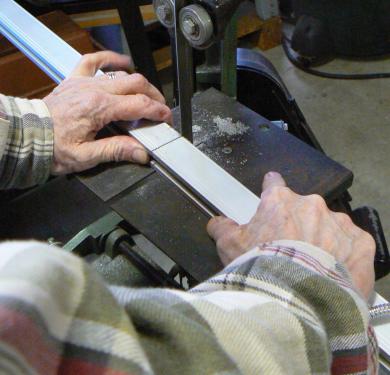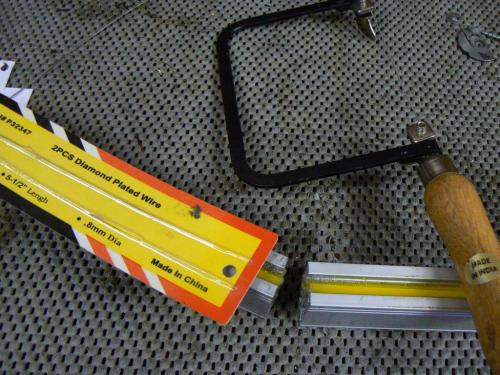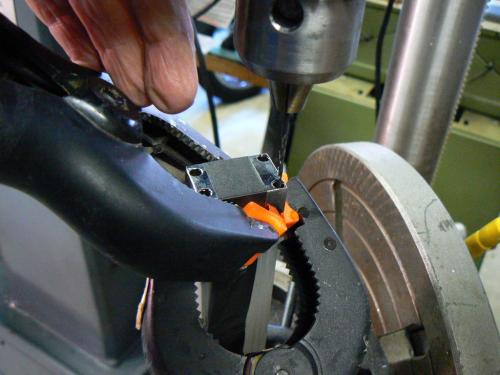01-19-2018, 05:47 PM
This morning I found a set of detailed instructions, including photos, in my e-mail explaining how to disassemble/reassemble the reading head and what is likely to be wrong with it. Took less than five minutes to fix the scale. And since I had it partially disassembled, I went ahead and cut it down.
There are various methods of doing this posted online and I decided to use a fairly conservative technique.
Note that the most daring thing that I saw, and he posted photos, was a brave man who just decided to bandsaw through everything at once, aluminum, flexible seal and glass. I couldn't imagine how that would accomplish anything except totally destroying the scale but apparently it was successful. However that was just a little too bold for me - wonder how the tips of the bandsaw blade held up.
My first step was to mark the length and scribe lines all the way around the aluminum extrusion, marking where the glass scale was with relation to the extrusion so that I could stop sawing just short of it.
Cut all the way around the extrusion stopping at the marks for the scale:

Some folks just broke the glass scale to length, some sawed it off with a diamond wheel in a Dremel tool, I found that neither of these methods were appropriate. The glass scale could not be removed from the extrusion and it must be cut off about an inch INSIDE the end of the extrusion so the glass was inaccessible to either technique.
I couldn't cut the extrusion completely away from the glass because there are two ledges in the extrusion that hold the glass in place - can't cut through those without cutting the glass.
Fortunately I had a diamond blade in a small coping saw for just this type of rainy day, so a few minutes work and the scale was cut. I had some worries about the heat generated by the Dremel/diamond wheel anyway so I felt much more comfortable with hand-sawing. The blade, if interested, came from the HF store.

Now the nasty part, removing the glass for about an inch behind the end of the extrusion. No matter how one decides to do this, safety glasses, while should always be worn, are REALLY important when dealing with glass.
I'd read that this could be easiest done with a pair of end nippers, just nibbling away at the end of the glass slide until the correct length is achieved. Unhappily, I had the same experience as another fellow on the internet did - the glass cracked diagonally for about two inches when I tried to nip it.
BUT, as the other person said, ugly as it looks, it's no big deal since the reading head can't go all the way to the end of the extrusion anyway and the flaw can't be seen when the end cap is screwed on.
Next step was to re-drill and tap the holes on the end of the extrusion. I did this on a light, floor model radial drill press with the table adjusted parallel with the spindle. I used the end cap as a drill guide and the two woodworking spring clamps held it securely aligned with the exterior of the extrusion.

The screws were metric, around 2.0 mm and I don't have any metric taps that small. I have 2-56 taps but didn't have any 2-56 screws x 3/4 long, which were required. So I drilled the holes about .010 undersize and self-tapped the metric screws into the extrusion which is dead soft aluminum - worked fine.
After drilling and blowing out the extrusion thoroughly (I figure some of the shavings from the bandsaw had to be inside) the end cap was reinstalled. Next step - and the most tedious - will be devising and making mounting provisions.
There are various methods of doing this posted online and I decided to use a fairly conservative technique.
Note that the most daring thing that I saw, and he posted photos, was a brave man who just decided to bandsaw through everything at once, aluminum, flexible seal and glass. I couldn't imagine how that would accomplish anything except totally destroying the scale but apparently it was successful. However that was just a little too bold for me - wonder how the tips of the bandsaw blade held up.
My first step was to mark the length and scribe lines all the way around the aluminum extrusion, marking where the glass scale was with relation to the extrusion so that I could stop sawing just short of it.
Cut all the way around the extrusion stopping at the marks for the scale:
Some folks just broke the glass scale to length, some sawed it off with a diamond wheel in a Dremel tool, I found that neither of these methods were appropriate. The glass scale could not be removed from the extrusion and it must be cut off about an inch INSIDE the end of the extrusion so the glass was inaccessible to either technique.
I couldn't cut the extrusion completely away from the glass because there are two ledges in the extrusion that hold the glass in place - can't cut through those without cutting the glass.
Fortunately I had a diamond blade in a small coping saw for just this type of rainy day, so a few minutes work and the scale was cut. I had some worries about the heat generated by the Dremel/diamond wheel anyway so I felt much more comfortable with hand-sawing. The blade, if interested, came from the HF store.
Now the nasty part, removing the glass for about an inch behind the end of the extrusion. No matter how one decides to do this, safety glasses, while should always be worn, are REALLY important when dealing with glass.
I'd read that this could be easiest done with a pair of end nippers, just nibbling away at the end of the glass slide until the correct length is achieved. Unhappily, I had the same experience as another fellow on the internet did - the glass cracked diagonally for about two inches when I tried to nip it.
BUT, as the other person said, ugly as it looks, it's no big deal since the reading head can't go all the way to the end of the extrusion anyway and the flaw can't be seen when the end cap is screwed on.
Next step was to re-drill and tap the holes on the end of the extrusion. I did this on a light, floor model radial drill press with the table adjusted parallel with the spindle. I used the end cap as a drill guide and the two woodworking spring clamps held it securely aligned with the exterior of the extrusion.
The screws were metric, around 2.0 mm and I don't have any metric taps that small. I have 2-56 taps but didn't have any 2-56 screws x 3/4 long, which were required. So I drilled the holes about .010 undersize and self-tapped the metric screws into the extrusion which is dead soft aluminum - worked fine.
After drilling and blowing out the extrusion thoroughly (I figure some of the shavings from the bandsaw had to be inside) the end cap was reinstalled. Next step - and the most tedious - will be devising and making mounting provisions.








